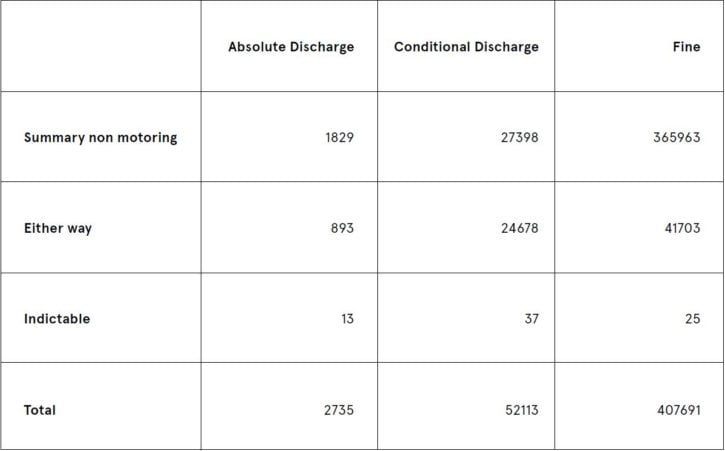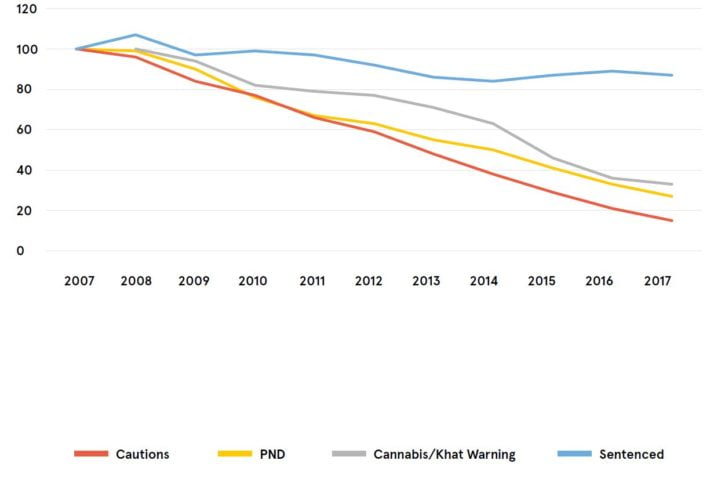Less is more
A new (7 December 2017) report by Rob Allen (@robroballen) for Transform Justice questions why the number of people diverted from prosecution and dealt with by out-of-court disposals has dropped so markedly over the last decade. There is, after all, a strong evidence base that keeping people out of the justice system, not labelling them as offenders or putting them in environments with lots of other offenders, is effective at preventing reoffending.
Context
Rob Allen is a much-respected criminal justice analyst and commentator, whose comprehensive knowledge of the justice system allows him to present an argument in a direct, straightforward and easy-to-follow manner.
This report starts by noting that England and Wales has a long-standing tradition of diverting first time and minor offenders from prosecution. While the practice is most fully developed for children who commit crime, a wide range of out of court disposals exists for adults too. A community resolution, simple or conditional caution, drug warning or penalty notice can be administered quickly, cheaply and locally, allowing the police to concentrate on more serious crime.
Diversion can work better than prosecution at reducing reoffending, and is generally acceptable to victims as long as they are kept properly informed. Some judges, magistrates and lawyers think that offenders may accept a caution in circumstances when they are not guilty of an offence, or do not understand the implications for their criminal record.
They are concerned that too many cases are diverted which should properly come to court. Yet many people who do go to court get low level penalties such as fines which could, in effect, be imposed out of court and which do nothing to help tackle any underlying problems an offender may have. Indeed, in 2016, more than 450,000 cases which went to court resulted in the offender getting a discharge or a fine; this figure includes almost 6,000 people who had no previous cautions or convictions. The table below shows the number of offenders sentenced to absolute and conditional discharges and fines at all groups (divided by seriousness of offence):

It certainly seems that there is scope for greater use of diversion.
Diversion going out of fashion
Recent years have however seen a large decline in the use of diversion. More than half of first time offenders now go to court rather than receive a caution, compared to 1 in 5 ten years ago. The decline partly results from a desire to end a “cautions culture” by restricting the availability and use of out of court disposals.
The report has calculated the steep decline in cautions, Penalty Notices for Disorder and Cannabis/Khat warnings over the last decade:

New two tier system
Alongside measures to limit diversion for serious and repeat offenders, the government intends to replace the existing range of options with just two – a community resolution and conditional caution.
Three police forces have been piloting the two tier system and, while the evaluation is yet to be published, it seems clear that, if diversion is to fulfil its potential, a number of measures will need to be taken. These include:
- Encouraging police to use their discretion and professional skills to resolve minor problems and disputes at the lowest level locally without the need to take formal action.
- Making sure that more first time offenders and cases which are likely to be dealt with by an absolute or conditional discharge or small fine are instead dealt with outside court – including many cases currently dealt with under the “single justice procedure”.
- Extending the approach to diverting children away from the courts to young adults, so that they are given a greater opportunity to grow out of crime.
- Identifying and promoting the best models for scrutinising diversion arrangements.
- Funding a suitable range of treatment options (including restorative justice) to be attached to community resolutions and conditional cautions.
- Developing a justice reinvestment approach which uses the savings which diversion brings to police, prosecutors and courts to fund local programmes designed to further reduce crime and prevent offending.
Conclusion
Given the evidence base that diversion is a positive activity which can help prevent the development of criminal patterns of behaviour and the urgent and continuing need to save resources (the MoJ will have lost 40% of its 2010 budget in real terms by 2020 according to the Law Society Gazette), it seems particularly perverse to be prosecuting so many people for minor offences.
Blog posts in the Criminal Justice category are kindly sponsored by Get the Data which provides Social Impact Analytics to enable organisations to demonstrate their impact on society. GtD has no editorial influence on the contents of this site.







